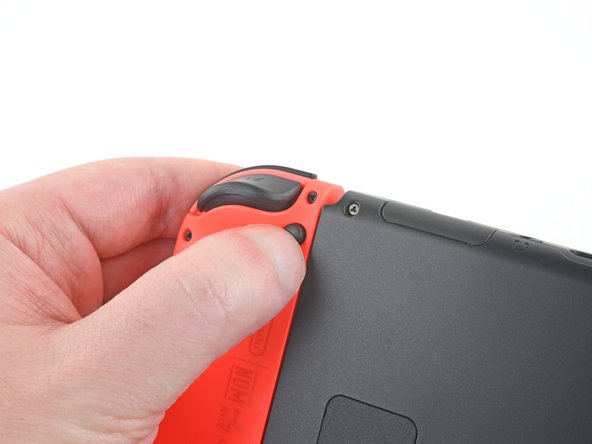Esta versão pode conter edições incorretas. Mude para o último instantâneo verificado.
O que você precisa
-
Este passo não foi traduzido. Ajude a traduzi-lo
-
Press and hold down the small round button on the back of the Joy Con controller.
-
While you hold down the button, slide the controller upward.
-
-
Este passo não foi traduzido. Ajude a traduzi-lo
-
Continue sliding the Joy Con upward until it's completely removed from the console.
-
-
Este passo não foi traduzido. Ajude a traduzi-lo
-
Use a Y00 screwdriver to remove the four 6.3 mm-long screws securing the rear panel.
-
-
Este passo não foi traduzido. Ajude a traduzi-lo
-
Use a JIS 000 driver or an official iFixit PH 000 driver to remove the following screws securing the rear panel:
-
One 2.5 mm-long screw on the top edge of the device
-
Two 2.5 mm-long screws on the bottom edge of the device
-
-
Este passo não foi traduzido. Ajude a traduzi-lo
-
Use a JIS 000 screwdriver or an official iFixit PH 000 driver to remove the two 3.8 mm center screws on the sides of the device (one on each side).
-
-
Este passo não foi traduzido. Ajude a traduzi-lo
-
Use your finger to flip up the kickstand on the back of the device.
-
-
Este passo não foi traduzido. Ajude a traduzi-lo
-
Use a JIS 000 screwdriver or an official iFixit PH 000 driver to remove the 1.6 mm screw in the kickstand well.
-
Close the kickstand.
-
-
Este passo não foi traduzido. Ajude a traduzi-lo
-
Open the game card cartridge flap.
-
Lift the rear panel up from the bottom of the device and remove it.
-
-
-
Este passo não foi traduzido. Ajude a traduzi-lo
-
Use a JIS 000 screwdriver or an official iFixit PH 000 driver to remove the six 3 mm screws securing the shield plate to the device.
-
-
Este passo não foi traduzido. Ajude a traduzi-lo
-
Use your fingers or a pair of tweezers to peel back the piece of foam on the top edge of the device near the fan exhaust port.
-
-
Este passo não foi traduzido. Ajude a traduzi-lo
-
Insert a spudger underneath the shield plate along the edge of the device.
-
Pry up to lift the shield plate and remove it from the device.
-
You can reuse the pink thermal compound if you're careful. Keep the compound clean and make sure it makes solid contact between the heat sink and the shield during reassembly.
-
If you need to replace it, refer to our thermal paste guide to remove the old thermal compound and replace it with an appropriate compound, such as K5 Pro, during reassembly.
-
-
Este passo não foi traduzido. Ajude a traduzi-lo
-
Use the point of a spudger to pry the battery connector straight up and out of its socket on the motherboard.
-
-
Este passo não foi traduzido. Ajude a traduzi-lo
-
Use a JIS 000 screwdriver or an official iFixit PH 000 driver to remove the three 3 mm screws securing the heat sink to the motherboard.
-
-
Este passo não foi traduzido. Ajude a traduzi-lo
-
Carefully peel the two foam pieces stuck over both the heatsink and the fan away from the fan.
-
Insert the point of a spudger underneath the part of the foam that isn't stuck against anything,
-
Press the top of the foam with your finger to hold it in place.
-
Roll the spudger tip underneath the foam all the way to the other end of the foam to release it.
-
-
Este passo não foi traduzido. Ajude a traduzi-lo
-
Use a spudger or your fingers to lift the heatsink up and off the motherboard to remove it.
-
Apply thermal paste to all surfaces that had thermal paste applied previously. This includes between the heatpipe and aluminum shield, which the Switch uses as additional heatsinking.
-
-
Este passo não foi traduzido. Ajude a traduzi-lo
-
Use an opening tool, spudger, or your fingernail to flip up the small, hinged locking flap on the fan cable ZIF connector.
-
-
Este passo não foi traduzido. Ajude a traduzi-lo
-
Use a pair of tweezers to pull the fan cable straight out of its connector on the motherboard.
-
-
Este passo não foi traduzido. Ajude a traduzi-lo
-
Use a JIS 000 screwdriver or an official iFixit PH 000 driver to remove the three 4.8 mm screws securing the fan.
-
-
Este passo não foi traduzido. Ajude a traduzi-lo
-
Use a pair of tweezers or your fingers to lift the fan straight up and remove it from the device.
-
-
Este passo não foi traduzido. Ajude a traduzi-lo
-
Use a spudger to flip up the small black locking flap on the power/volume ribbon cable ZIF connector.
-
-
Este passo não foi traduzido. Ajude a traduzi-lo
-
Use the flat end of a spudger to pry up the taped down power/volume ribbon cable.
-
-
Este passo não foi traduzido. Ajude a traduzi-lo
-
Remove the power/volume board with a pair of blunt nose tweezers.
-
-
Este passo não foi traduzido. Ajude a traduzi-lo
-
Pull the rubber conductive pad out with a pair of blunt nose tweezers.
-
-
Este passo não foi traduzido. Ajude a traduzi-lo
-
Pull the power and volume buttons out with a pair of blunt nose tweezers.
-
Cancelar: não concluí este guia.
10 outras pessoas executaram este guia.
3 comentários
What happens if the small black locking flap breaks?
Two angles are congruent if they have the same measure. You already know that when two lines intersect the vertical angles formed are congruent. You have also seen that if ∠A and ∠B are each complementary to ∠C, then ∠A ~= ∠B. There are other angle relationships to explore. When you expose these angle relationships, you will establish their truth using a formal proof.
This guide is missing the steps to Remove the microSD card reader and the steps to Remove the headphone jack and game card reader













































